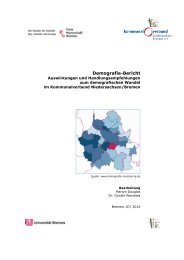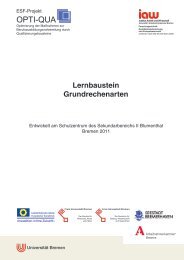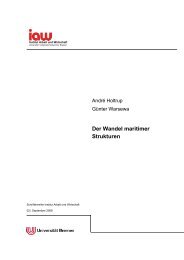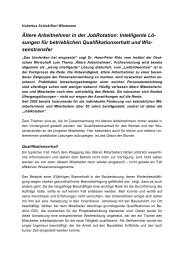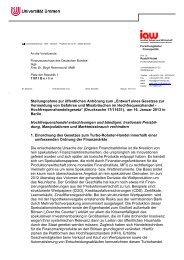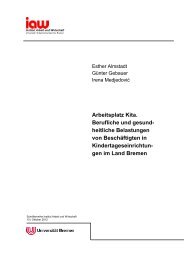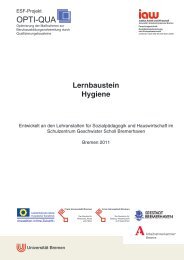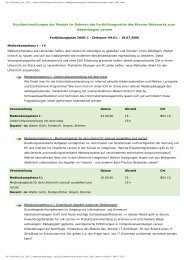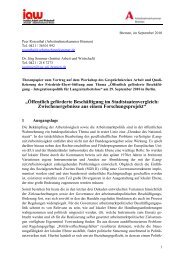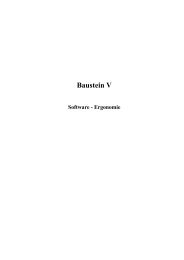3. Measures to deal with cyclical fluctuations in demand
3. Measures to deal with cyclical fluctuations in demand
3. Measures to deal with cyclical fluctuations in demand
Create successful ePaper yourself
Turn your PDF publications into a flip-book with our unique Google optimized e-Paper software.
Shipbuild<strong>in</strong>g <strong>in</strong> Europe –<br />
between Co-operation operation and Competition<br />
19-20 June 2006, Papenburg, , Germany<br />
Manag<strong>in</strong>g <strong>cyclical</strong> changes <strong>in</strong> the European shipbuild<strong>in</strong>g<br />
and ship repair<strong>in</strong>g <strong>in</strong>dustries: Evidence from across Europe<br />
Xabier Iras<strong>to</strong>rza<br />
Research Officer<br />
European Foundation for the Improvement of<br />
Liv<strong>in</strong>g and Work<strong>in</strong>g Conditions<br />
27/07/2006<br />
1
1. Introduction<br />
Content<br />
2. Structure of the <strong>in</strong>dustries<br />
<strong>3.</strong> <strong>Measures</strong> <strong>to</strong> <strong>deal</strong> <strong>with</strong> <strong>cyclical</strong> <strong>fluctuations</strong> <strong>in</strong><br />
<strong>demand</strong><br />
4. Effectiveness of the various measures<br />
5. Conclusions<br />
27/07/2006 2
Study<br />
Dates January – March 2006<br />
Research Team • National reports: National Experts<br />
• Consolidated report: EMCC<br />
Countries covered • Poland<br />
• Denmark<br />
• France<br />
• Germany<br />
• Italy<br />
• Malta<br />
• Portugal<br />
• Spa<strong>in</strong><br />
• The Netherlands<br />
• United K<strong>in</strong>gdom<br />
27/07/2006 3
1. Introduction<br />
Shipbuild<strong>in</strong>g and ship repair<strong>in</strong>g:<br />
• Cyclical <strong>fluctuations</strong> <strong>in</strong> <strong>demand</strong>: <strong>in</strong>tr<strong>in</strong>sic characteristic.<br />
• Inflexible production and service capacities.<br />
Essential for European <strong>in</strong>dustries <strong>to</strong>:<br />
• Increase capacity <strong>to</strong> react flexibly.<br />
• Reta<strong>in</strong> access <strong>to</strong> highly qualified workforce.<br />
Crucial <strong>to</strong> f<strong>in</strong>d mechanisms <strong>to</strong> <strong>deal</strong> <strong>with</strong> <strong>cyclical</strong> changes <strong>in</strong><br />
<strong>demand</strong> <strong>in</strong> a socially responsible way<br />
27/07/2006 4
1. Introduction<br />
Content<br />
2. Structure of the <strong>in</strong>dustries<br />
<strong>3.</strong> <strong>Measures</strong> <strong>to</strong> <strong>deal</strong> <strong>with</strong> <strong>cyclical</strong> <strong>fluctuations</strong> <strong>in</strong><br />
<strong>demand</strong><br />
4. Effectiveness of the various measures<br />
5. Conclusions<br />
27/07/2006 5
2. Structure of the <strong>in</strong>dustries (1)<br />
A. Industrial structure and developments <strong>in</strong> employment<br />
and production<br />
• Transition process after crisis <strong>in</strong> 1980s/1990s:<br />
<br />
<br />
Shipbuild<strong>in</strong>g: economic concentration (country-specific).<br />
Ship repair<strong>in</strong>g: geographically concentrated SMEs.<br />
• Enterprise size consideration.<br />
• Increased cost competition Specialisation shift from blue <strong>to</strong> white<br />
collar employment.<br />
• Shift from direct <strong>to</strong> <strong>in</strong>direct employment (outsourc<strong>in</strong>g/subcontract<strong>in</strong>g)<br />
• Steady decrease of employment / shortage of skilled labour.<br />
27/07/2006 6
2. Structure of the <strong>in</strong>dustries (2)<br />
B. Patterns of <strong>cyclical</strong> <strong>fluctuations</strong> (1)<br />
Nature of<br />
production process<br />
Patterns of <strong>cyclical</strong><br />
fluctuation<br />
Shipbuild<strong>in</strong>g<br />
• Manufactur<strong>in</strong>g <strong>in</strong>dustry.<br />
• Capital and know-how<br />
<strong>in</strong>tensive.<br />
• 1-2 contracts per year.<br />
• Long cycles.<br />
Ship repair<strong>in</strong>g<br />
• Service <strong>in</strong>dustry<br />
• Labour <strong>in</strong>tensive service<br />
• 200-300 contracts/year.<br />
• Short, frequent cycles.<br />
• Irregularity of workload:<br />
difficulty <strong>to</strong> plan ahead.<br />
27/07/2006 7
2. Structure of the <strong>in</strong>dustries (3)<br />
B. Patterns of <strong>cyclical</strong> <strong>fluctuations</strong> (2)<br />
Fac<strong>to</strong>rs Shipbuild<strong>in</strong>g Ship repair<strong>in</strong>g<br />
External<br />
Internal<br />
Macroeconomic/political<br />
developments:<br />
• Demand.<br />
• Prices.<br />
• Macro-political<br />
developments at EU level.<br />
• Price quoted.<br />
• Long production cycles.<br />
• Several successive,<br />
dist<strong>in</strong>ct, long phases.<br />
• Volume of ship freight and variations<br />
<strong>in</strong> freight rates.<br />
• Price, Time and Costs.<br />
• Difficulty <strong>in</strong> forward plann<strong>in</strong>g.<br />
• Specialisation: sensitive <strong>to</strong> seasonal<br />
<strong>fluctuations</strong>.<br />
• Geographical proximity <strong>to</strong> buyers.<br />
• Different conditions by submarket.<br />
27/07/2006 8
2. Structure of the <strong>in</strong>dustries (4)<br />
B. Patterns of <strong>cyclical</strong> <strong>fluctuations</strong> (3)<br />
Remarks/Qualifications<br />
Shipbuild<strong>in</strong>g<br />
Ship repair<strong>in</strong>g<br />
• Different conditions:<br />
By sub-sec<strong>to</strong>r.<br />
By country.<br />
• Difficulty <strong>to</strong> dist<strong>in</strong>guish shortterm<br />
from long-term <strong>cyclical</strong><br />
challenges.<br />
• Random and highly unpredictable<br />
nature of <strong>demand</strong>.<br />
• Low visibility of order books.<br />
• Problems <strong>in</strong> strategic forward<br />
plann<strong>in</strong>g.<br />
• Crucial: ensure high adaptability of<br />
workforce (quantity/quality).<br />
27/07/2006 9
1. Introduction<br />
Content<br />
2. Structure of the <strong>in</strong>dustries<br />
<strong>3.</strong> <strong>Measures</strong> <strong>to</strong> <strong>deal</strong> <strong>with</strong> <strong>cyclical</strong> <strong>fluctuations</strong> <strong>in</strong><br />
<strong>demand</strong><br />
4. Effectiveness of the various measures<br />
5. Conclusions<br />
27/07/2006 10
<strong>3.</strong> <strong>Measures</strong> <strong>to</strong> <strong>deal</strong> <strong>with</strong> <strong>cyclical</strong><br />
<strong>fluctuations</strong> <strong>in</strong> <strong>demand</strong> (1)<br />
Goal<br />
Focus of report<br />
Caution<br />
Adapt rapidly <strong>to</strong> chang<strong>in</strong>g market conditions.<br />
Identify/analyse solutions aimed at:<br />
• Increas<strong>in</strong>g the companies’ <strong>in</strong>ternal flexibility.<br />
• Reta<strong>in</strong><strong>in</strong>g access <strong>to</strong> a well-tra<strong>in</strong>ed workforce.<br />
Transferability<br />
Types of measures<br />
• Work<strong>in</strong>g time arrangements<br />
• Changes <strong>in</strong> work organisation<br />
• F<strong>in</strong>ancial concession and<br />
support<br />
Aspects <strong>to</strong> be taken <strong>in</strong><strong>to</strong> account<br />
• Nature of cycle: short vs. long.,<br />
downsw<strong>in</strong>g vs. upsw<strong>in</strong>g.<br />
• Temporary vs. permanent<br />
measures.<br />
• <strong>Measures</strong> used <strong>in</strong> comb<strong>in</strong>ation.<br />
27/07/2006 11
<strong>3.</strong> <strong>Measures</strong> <strong>to</strong> <strong>deal</strong> <strong>with</strong> <strong>cyclical</strong><br />
<strong>fluctuations</strong> <strong>in</strong> <strong>demand</strong> (2)<br />
A. Work<strong>in</strong>g time arrangements (1)<br />
Goal<br />
Adapt volume of labour <strong>to</strong> <strong>demand</strong> variations through flexible<br />
distribution of work<strong>in</strong>g hours.<br />
Tools • Overtime/short-time.<br />
• Work<strong>in</strong>g time accounts.<br />
Differences • Overtime/short-time more complicated for employers:<br />
bureaucratic application, overtime pay.<br />
• Work<strong>in</strong>g time accounts: reduce wage bill / same flexibility.<br />
F<strong>in</strong>d<strong>in</strong>gs • Uneven distribution across Europe.<br />
• No differences <strong>in</strong> use between two <strong>in</strong>dustries.<br />
• Work organisation measures more widely used.<br />
27/07/2006 12
<strong>3.</strong> <strong>Measures</strong> <strong>to</strong> <strong>deal</strong> <strong>with</strong> <strong>cyclical</strong><br />
<strong>fluctuations</strong> <strong>in</strong> <strong>demand</strong> (3)<br />
A. Work<strong>in</strong>g time arrangements (2)<br />
I. Overtime/short time work<br />
Demand troughs<br />
Use by country<br />
Use by sec<strong>to</strong>r<br />
• Temporary reduction of work<strong>in</strong>g hours and pay.<br />
• Income complemented <strong>with</strong> public funds (Germany,<br />
France, Italy).<br />
• Limited <strong>in</strong> Germany and The Netherlands (vis-à-vis<br />
work<strong>in</strong>g time accounts).<br />
• More frequent <strong>in</strong> Italy and Portugal.<br />
• No conv<strong>in</strong>c<strong>in</strong>g evidence. The Netherlands.<br />
27/07/2006 13
<strong>3.</strong> <strong>Measures</strong> <strong>to</strong> <strong>deal</strong> <strong>with</strong> <strong>cyclical</strong><br />
<strong>fluctuations</strong> <strong>in</strong> <strong>demand</strong> (4)<br />
A. Work<strong>in</strong>g time arrangements (3)<br />
II.<br />
Work<strong>in</strong>g time accounts<br />
Collective agreement at sec<strong>to</strong>ral/ company level:<br />
• Hours <strong>to</strong> be worked by each employee.<br />
• Reference period for compensation of hours.<br />
• Maximum number of work<strong>in</strong>g hours.<br />
Advantages<br />
Use<br />
• Rapid reaction <strong>to</strong> <strong>cyclical</strong> upturns/downturns <strong>in</strong> <strong>demand</strong>.<br />
• No overtime has <strong>to</strong> be paid <strong>in</strong> <strong>cyclical</strong> peaks.<br />
Not very widespread throughout Europe:<br />
• Employers <strong>in</strong> favour <strong>in</strong> most countries.<br />
• Trade unions position.<br />
27/07/2006 14
<strong>3.</strong> <strong>Measures</strong> <strong>to</strong> <strong>deal</strong> <strong>with</strong> <strong>cyclical</strong><br />
<strong>fluctuations</strong> <strong>in</strong> <strong>demand</strong> (5)<br />
B. Changes <strong>in</strong> work organisation (1)<br />
Quantitative adjustment of workforce size <strong>to</strong> <strong>cyclical</strong> <strong>fluctuations</strong><br />
I. Outsourc<strong>in</strong>g and subcontract<strong>in</strong>g<br />
II.<br />
III.<br />
Use of temporary workers and fixed-term contracts<br />
Secondment schemes and staff pools<br />
Qualitative adaptation of workers <strong>to</strong> <strong>cyclical</strong> changes by foster<strong>in</strong>g their<br />
polyvalence (<strong>in</strong>ternal functional flexibility)<br />
IV.<br />
Tra<strong>in</strong><strong>in</strong>g <strong>in</strong>itiatives<br />
27/07/2006 15
<strong>3.</strong> <strong>Measures</strong> <strong>to</strong> <strong>deal</strong> <strong>with</strong> <strong>cyclical</strong><br />
<strong>fluctuations</strong> <strong>in</strong> <strong>demand</strong> (6)<br />
B. Changes <strong>in</strong> work organisation (2)<br />
I. Outsourc<strong>in</strong>g and subcontract<strong>in</strong>g<br />
Goal<br />
Focus on core competencies and respond <strong>to</strong> rigid regula<strong>to</strong>ry framework<br />
• Reduce fixed personnel costs.<br />
• Externalise risk of <strong>cyclical</strong> <strong>fluctuations</strong>.<br />
Ma<strong>in</strong> reasons • Technological justification.<br />
• Shifts <strong>in</strong> volume.<br />
• Cost.<br />
Consequences • Increased flexibility / reduced fixed labour costs.<br />
• Coord<strong>in</strong>ation / loss of knowledge and skills.<br />
Use<br />
No clear pattern.<br />
27/07/2006 16
<strong>3.</strong> <strong>Measures</strong> <strong>to</strong> <strong>deal</strong> <strong>with</strong> <strong>cyclical</strong><br />
<strong>fluctuations</strong> <strong>in</strong> <strong>demand</strong> (7)<br />
B. Changes <strong>in</strong> work organisation (3)<br />
II.<br />
Use of temporary workers and fixed-term contracts<br />
Increased flexibility while m<strong>in</strong>imis<strong>in</strong>g costs due <strong>to</strong> reduced permanent staff<br />
Temporary workers<br />
Fixed-term contracts<br />
Usually employed by an employment agency.<br />
Directly by the company for a specified period of time.<br />
Consequences<br />
• Employer: lower wages and fr<strong>in</strong>ge benefits than<br />
permanent staff / same problems as outsourc<strong>in</strong>g.<br />
• Employee: dramatic decrease <strong>in</strong> employment security.<br />
Use<br />
More common among SMEs, ship repair<strong>in</strong>g and<br />
subcontrac<strong>to</strong>rs SIZE consideration<br />
27/07/2006 17
<strong>3.</strong> <strong>Measures</strong> <strong>to</strong> <strong>deal</strong> <strong>with</strong> <strong>cyclical</strong><br />
<strong>fluctuations</strong> <strong>in</strong> <strong>demand</strong> (8)<br />
B. Changes <strong>in</strong> work organisation (4)<br />
III.<br />
Secondment schemes and staff pools<br />
Flexible adjustment <strong>with</strong><strong>in</strong> the core workforce: company-<strong>in</strong>ternal and <strong>in</strong>ter-company<br />
Advantage for employers • Reta<strong>in</strong> highly skilled workers<br />
• ‘Adjusted’ skilled workforce <strong>to</strong> <strong>demand</strong> peaks/lows.<br />
• Split workforce cost among employers<br />
Advantage for employees<br />
Use<br />
Employment and <strong>in</strong>come security<br />
• Sporadic. Germany, The Netherlands (Deltametaal).<br />
• Shipbuild<strong>in</strong>g vs. ship repair<strong>in</strong>g.<br />
27/07/2006 18
<strong>3.</strong> <strong>Measures</strong> <strong>to</strong> <strong>deal</strong> <strong>with</strong> <strong>cyclical</strong><br />
<strong>fluctuations</strong> <strong>in</strong> <strong>demand</strong> (9)<br />
B. Changes <strong>in</strong> work organisation (5)<br />
IV.<br />
Tra<strong>in</strong><strong>in</strong>g <strong>in</strong>itiatives<br />
Improve workers’ capacity <strong>to</strong> adapt qualitatively <strong>to</strong> <strong>cyclical</strong> changes<br />
Additional function<br />
Relevance for <strong>in</strong>dustry<br />
Use<br />
Attract new people <strong>to</strong> the <strong>in</strong>dustry<br />
• Long adaptation period of young workers<br />
• Shortage of skilled labour <strong>in</strong> both <strong>in</strong>dustries:<br />
employment cuts / age<strong>in</strong>g<br />
• Production cycle of shipbuild<strong>in</strong>g<br />
• Country-specific and company-specific measures.<br />
• Cooperation <strong>with</strong> education centres/public authorities.<br />
27/07/2006 19
<strong>3.</strong> <strong>Measures</strong> <strong>to</strong> <strong>deal</strong> <strong>with</strong> <strong>cyclical</strong><br />
<strong>fluctuations</strong> <strong>in</strong> <strong>demand</strong> (10)<br />
C. F<strong>in</strong>ancial concession and support<br />
Some examples:<br />
• Direct state subsidies: ‘Temporary Defence Mechanism’. March 2005.<br />
• New European Commission Framework.<br />
• Placement of state orders for military ships (UK)<br />
F<strong>in</strong>ancial measures aimed at manag<strong>in</strong>g periods of weak <strong>demand</strong>:<br />
Public Income Support<br />
Examples from several countries.<br />
Company specific agreements • Temporary cost reductions and <strong>in</strong>crease<br />
<strong>in</strong> work<strong>in</strong>g time flexibility.<br />
• Employment security.<br />
27/07/2006 20
Summary<br />
<strong>3.</strong> <strong>Measures</strong> <strong>to</strong> <strong>deal</strong> <strong>with</strong> <strong>cyclical</strong><br />
<strong>fluctuations</strong> <strong>in</strong> <strong>demand</strong> (11)<br />
Work<strong>in</strong>g time<br />
arrangements<br />
• Overtime/short-time work.<br />
• Work<strong>in</strong>g time accounts.<br />
Changes <strong>in</strong> work<br />
organisation<br />
F<strong>in</strong>ancial concession and<br />
support<br />
Quantitative adjustment:<br />
• Outsourc<strong>in</strong>g and subcontract<strong>in</strong>g.<br />
• Temporary workers/fixed-term contracts<br />
• Secondment schemes and staff pools<br />
Qualitative adaptation:<br />
• Tra<strong>in</strong><strong>in</strong>g <strong>in</strong>itiatives<br />
• Public <strong>in</strong>come support.<br />
• Company specific agreements.<br />
27/07/2006 21
1. Introduction<br />
Content<br />
2. Structure of the <strong>in</strong>dustries<br />
<strong>3.</strong> <strong>Measures</strong> <strong>to</strong> <strong>deal</strong> <strong>with</strong> <strong>cyclical</strong> <strong>fluctuations</strong> <strong>in</strong><br />
<strong>demand</strong><br />
4. Effectiveness of the various measures<br />
5. Conclusions<br />
27/07/2006 22
4. Effectiveness of the various measures (1)<br />
OPTIONS<br />
Flexible work<strong>in</strong>g time<br />
arrangements<br />
Quantitative adjustment<br />
PRACTICES<br />
• Overtime/short-time work.<br />
• Work<strong>in</strong>g time accounts.<br />
• Secondment schemes.<br />
• Public <strong>in</strong>come support measures.<br />
Externalisation of adjustment • Outsourc<strong>in</strong>g/subcontract<strong>in</strong>g.<br />
problems • Use of temporary workers.<br />
Qualitative adjustment<br />
• Tra<strong>in</strong><strong>in</strong>g schemes for exist<strong>in</strong>g<br />
workforce.<br />
27/07/2006 23
4. Effectiveness of the various measures (2)<br />
Choice and effectiveness<br />
• Heavily dependant on country and companyspecific<br />
conditions<br />
• Key role of tra<strong>in</strong><strong>in</strong>g:<br />
<br />
<br />
In-house.<br />
State-provided <strong>in</strong>stitutional framework:<br />
essential for smaller enterprises.<br />
Important framework<br />
conditions:<br />
• Legal and <strong>in</strong>stitutional context and traditional<br />
patterns of <strong>in</strong>dustrial relations.<br />
• Structure of <strong>in</strong>dustries.<br />
27/07/2006 24
4. Effectiveness of the various measures (3)<br />
I. Legal and <strong>in</strong>stitutional context and traditional patterns<br />
of <strong>in</strong>dustrial relations<br />
Country specific<br />
constra<strong>in</strong>ts<br />
Cooperative relations<br />
Adversarial relations<br />
• Rigid/flexible frameworks.<br />
• Cooperative/adversarial relations of social partners.<br />
Key element.<br />
• Needs/<strong>in</strong>terests of both social partners.<br />
• Role of the state <strong>in</strong> foster<strong>in</strong>g social dialogue.<br />
• Work<strong>in</strong>g time accounts, company-specific<br />
agreements, transfer companies/staff pools.<br />
• Limited scope of action.<br />
• Less quantitative adjustment/flexible work<strong>in</strong>g time.<br />
• Early retirement, temporary employment,<br />
outsourc<strong>in</strong>g, tra<strong>in</strong><strong>in</strong>g of employees.<br />
27/07/2006 25
4. Effectiveness of the various measures (4)<br />
II.<br />
Structure of <strong>in</strong>dustries<br />
Degree of concentration<br />
• One big company determ<strong>in</strong>es conditions.<br />
• Extremely strong position vis-à-vis subcontrac<strong>to</strong>rs.<br />
• Risks of <strong>cyclical</strong> <strong>fluctuations</strong> externalised through sub-contract<strong>in</strong>g<br />
and outsourc<strong>in</strong>g : precarious employment more frequent <strong>in</strong> small<br />
companies.<br />
Degree of specialisation<br />
• High-tech and high-value added segments.<br />
• Increased complexity of production process<br />
• Increased need for enhanced competences and development of multiskilled<br />
workforce: much easier for larger companies.<br />
27/07/2006 26
1. Introduction<br />
Content<br />
2. Structure of the <strong>in</strong>dustries<br />
<strong>3.</strong> <strong>Measures</strong> <strong>to</strong> <strong>deal</strong> <strong>with</strong> <strong>cyclical</strong> <strong>fluctuations</strong> <strong>in</strong><br />
<strong>demand</strong><br />
4. Effectiveness of the various measures<br />
5. Conclusions<br />
27/07/2006 27
5. Ma<strong>in</strong> conclusions (1)<br />
Key fac<strong>to</strong>r<br />
Size more than sec<strong>to</strong>r (shipbuild<strong>in</strong>g vs. ship repair<strong>in</strong>g)<br />
Preferred method • Outsourc<strong>in</strong>g and subcontract<strong>in</strong>g, coupled <strong>with</strong>:<br />
<br />
<br />
Technical measures.<br />
More flexible use of own workforce.<br />
Smaller companies<br />
• Burden of <strong>cyclical</strong> <strong>fluctuations</strong> shifted <strong>to</strong> smaller<br />
subcontrac<strong>to</strong>rs.<br />
• Greater precarious employment (temporary and<br />
fixed-term contracts).<br />
27/07/2006 28
5. Ma<strong>in</strong> conclusions (2)<br />
No best way <strong>to</strong> <strong>deal</strong> <strong>with</strong> <strong>cyclical</strong> <strong>fluctuations</strong> <strong>in</strong> <strong>demand</strong>.<br />
Tools<br />
Dependant on country specific constra<strong>in</strong>ts, legal and <strong>in</strong>stitutional<br />
context and tradition of <strong>in</strong>dustrial relations.<br />
Outcomes • Dependant on perception/strategies of social partners and the<br />
nature of their <strong>in</strong>teraction. Will<strong>in</strong>gness <strong>to</strong> cooperate essential.<br />
Role of the State.<br />
• Role of three ac<strong>to</strong>rs <strong>in</strong> achiev<strong>in</strong>g <strong>in</strong>creased flexibility while<br />
ensur<strong>in</strong>g employment security at the same time.<br />
27/07/2006 29
European Moni<strong>to</strong>r<strong>in</strong>g Centre on Change<br />
http://www.emcc.eurofound.eu.<strong>in</strong>t/<br />
Study available on:<br />
• EMCC web page: end of July 2006.<br />
• Pr<strong>in</strong>ted format: end of August 2006.<br />
27/07/2006 30



